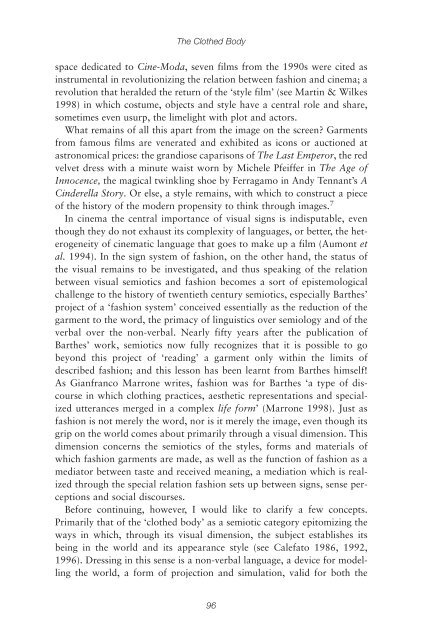You also want an ePaper? Increase the reach of your titles
YUMPU automatically turns print PDFs into web optimized ePapers that Google loves.
<strong>The</strong> <strong>Clothed</strong> <strong>Body</strong><br />
space dedicated to Cine-Moda, seven films from the 1990s were cited as<br />
instrumental in revolutionizing the relation between fashion and cinema; a<br />
revolution that heralded the return of the ‘style film’ (see Martin & Wilkes<br />
1998) in which costume, objects and style have a central role and share,<br />
sometimes even usurp, the limelight with plot and actors.<br />
What remains of all this apart from the image on the screen? Garments<br />
from famous films are venerated and exhibited as icons or auctioned at<br />
astronomical prices: the grandiose caparisons of <strong>The</strong> Last Emperor, the red<br />
velvet dress with a minute waist worn by Michele Pfeiffer in <strong>The</strong> Age of<br />
Innocence, the magical twinkling shoe by Ferragamo in Andy Tennant’s A<br />
Cinderella Story. Or else, a style remains, with which to construct a piece<br />
of the history of the modern propensity to think through images. 7<br />
In cinema the central importance of visual signs is indisputable, even<br />
though they do not exhaust its complexity of languages, or better, the heterogeneity<br />
of cinematic language that goes to make up a film (Aumont et<br />
al. 1994). In the sign system of fashion, on the other hand, the status of<br />
the visual remains to be investigated, and thus speaking of the relation<br />
between visual semiotics and fashion becomes a sort of epistemological<br />
challenge to the history of twentieth century semiotics, especially Barthes’<br />
project of a ‘fashion system’ conceived essentially as the reduction of the<br />
garment to the word, the primacy of linguistics over semiology and of the<br />
verbal over the non-verbal. Nearly fifty years after the publication of<br />
Barthes’ work, semiotics now fully recognizes that it is possible to go<br />
beyond this project of ‘reading’ a garment only within the limits of<br />
described fashion; and this lesson has been learnt from Barthes himself!<br />
As Gianfranco Marrone writes, fashion was for Barthes ‘a type of discourse<br />
in which clothing practices, aesthetic representations and specialized<br />
utterances merged in a complex life form’ (Marrone 1998). Just as<br />
fashion is not merely the word, nor is it merely the image, even though its<br />
grip on the world comes about primarily through a visual dimension. This<br />
dimension concerns the semiotics of the styles, forms and materials of<br />
which fashion garments are made, as well as the function of fashion as a<br />
mediator between taste and received meaning, a mediation which is realized<br />
through the special relation fashion sets up between signs, sense perceptions<br />
and social discourses.<br />
Before continuing, however, I would like to clarify a few concepts.<br />
Primarily that of the ‘clothed body’ as a semiotic category epitomizing the<br />
ways in which, through its visual dimension, the subject establishes its<br />
being in the world and its appearance style (see Calefato 1986, 1992,<br />
1996). Dressing in this sense is a non-verbal language, a device for modelling<br />
the world, a form of projection and simulation, valid for both the<br />
96

















